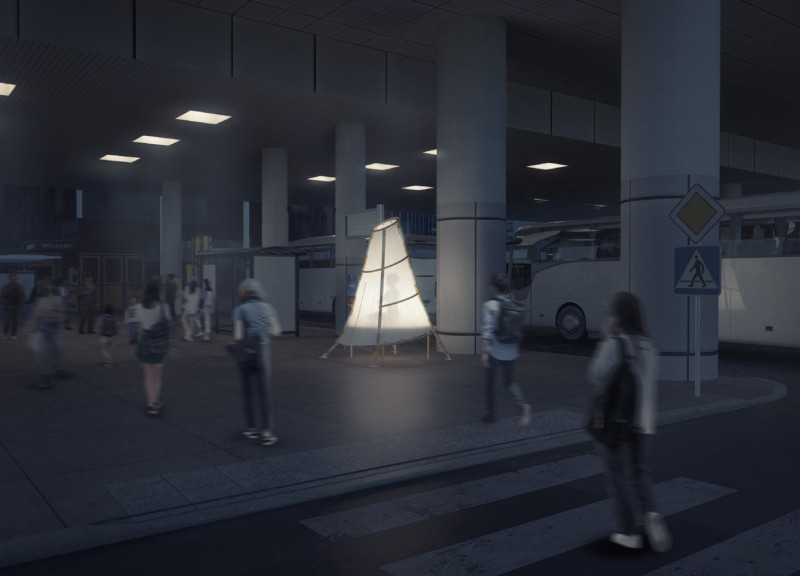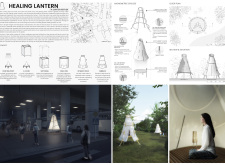5 key facts about this project
At first glance, the Healing Lantern features a distinctive cone-like shape that encourages a sense of enclosure and security. This design choice is intentional, promoting an atmosphere that feels both intimate and inviting. The geometry of the structure not only provides visual interest but also underscores its purpose as a calming space for meditation and contemplation. Key elements of the project include a flexible meditation deck incorporated into the base, which allows for various activities, from personal reflection to group sessions, reinforcing the communal aspect of mindfulness practices.
The architecture of the Healing Lantern utilizes a carefully selected palette of materials designed to enhance the user experience. Bamboo serves as the primary structural component due to its lightweight and robust properties, making it suitable for a portable design. Its natural aesthetic fosters a connection to the outdoors and encourages a sense of calm. The translucent fabric used as a cover enriches the interior atmosphere, filtering natural light while creating a soft, diffused glow that contributes to the overall healing environment. Additionally, galvanized steel is employed for the support elements, ensuring the structure’s longevity and stability without compromising the lightweight intention of the design.
What sets the Healing Lantern apart from traditional urban shelters is its adaptability. The architectural design allows it to be transported and positioned in diverse urban settings, such as parks, community squares, or other public spaces, where it can facilitate mindfulness and relaxation. This flexibility in placement ensures that various communities have access to a much-needed haven from the stressors of urban living.
An important aspect of the design is its user-centered approach. By prioritizing comfort and ease of use, the Healing Lantern creates an environment that encourages individuals to engage with the space actively. The careful consideration given to ergonomics and spatial organization fosters an abiding sense of well-being among users, enhancing the therapeutic qualities of the environment. This architectural design speaks to the growing recognition of mental health's significance in contemporary urban life, making it not just a physical structure but a crucial node for community engagement and personal healing.
The integration of sustainable practices further informs the unique approach of the Healing Lantern. By utilizing renewable resources such as bamboo for the main structure, the project aligns with contemporary ecological values, illustrating a commitment to environmentally conscious design. This consideration not only addresses structural integrity but reinforces the narrative of healing and connection to nature that the project embodies.
Overall, the Healing Lantern offers a compelling exploration of how architectural design can address mental health and well-being in urban settings. Its innovative use of materials, user-centered focus, and adaptability make it a noteworthy example of contemporary architecture that prioritizes the needs of individuals in increasingly busy environments. To gain a more in-depth understanding of this project, readers are encouraged to explore the architectural plans, sections, designs, and ideas that underlie this thoughtful initiative.























